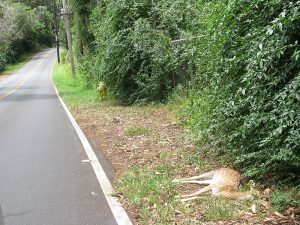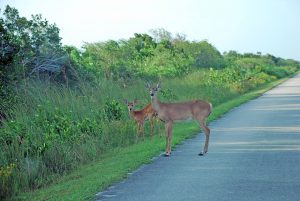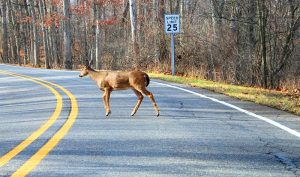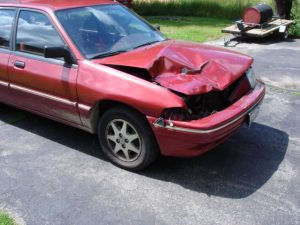It’s that time of year again where we see an increase in deer-vehicle collisions, which usually starts in October, and November is typically the worst month because that’s when mating season is at its peak.
Because the unseasonably warmer start to Fall this year, I have noticed while out traveling these Kentucky roads that I haven’t seen that many Deer this past month of October. Some believe that the cold weather triggers the Deer rut season, but that is not the case. Deer manage to get breed even during unusually warm fall conditions. Cold weather has no real effect on when deer breed. Weather isn’t going to affect the rut very much. The rut’s going to happen regardless of weather conditions.
Deer manage to get breed even during unusually warm fall conditions. Cold weather has no real effect on when deer breed. Weather isn’t going to affect the rut very much. The rut’s going to happen regardless of weather conditions.
According to an article in NorthAmericanWhiteetail.com whitetail deer are short-day breeders, meaning as days become shorter, certain physiological changes take place that prepares them for breeding. Their brain keeps track of day length in a curious “reverse” manner, using the concentration of melatonin (a chemical produced at night) in the blood. Production of various sex-related hormones then is stimulated to affect the testes and ovaries.
The fact that we all saw less deer in this past October had more to do with deer not feeling the need to their get-up-and-go going because of the unseasonably warm weather. When it’s cold deer have an increased need to acquire calories during cold weather. So, the fact that you see more deer moving during colder weather does not mean temperature triggered the rut. Also, deer feel more comfortable when the temperatures are cooler.

According to an article in Petersenhunting.com changes to the barometric pressure affect deer movement. Typically, when the barometer starts to drop, deer are on their feet. Research has also shown that high temperatures (“high” is relative to your location) result in more nocturnal activity, and heavy winds or intense rainfall will keep deer hunkered down as well. But not all moisture is bad: A slow, drizzling rain usually gets deer up and moving as well.
Deer “want” to breed shortly after a full moon and the next full moon will be November 12th and the peak of breeding in Kentucky is November 11 to November 21. Hence the reason why Kentucky Modern gun season is November 9-24.
Why do I tell you this? Well as a safety and risk management professional to better prevent an accident to that vehicle it’s best to know all the facts on that enemy of your front bumper.
The fact is whitetail deer happen to be the most dangerous animal in the state of Kentucky. According to a 2017 State Farm report, Kentucky is ranked 15th in the country for the most deer collisions.
The National Highway Traffic Safety Administration estimates that there are about one million car crashes annually that involve deer, killing about 200 people in the process.
In comparison, sharks kill about one person a year and bear about 28 in the past decade.
To better assist you with lowering your chances of having a deer collision here are some defensive driving tips for avoiding a deer: 
• Keep a close watch for deer in the early morning and evening hours. Deer are most active during these times.
• Slow down in posted deer crossing areas as well as at dusk and dawn. Those signs weren’t randomly placed there.
• Be especially alert when you are moving through a known deer crossing zone.
• Use your high-beam headlights whenever possible.
• Slow down immediately when you see a deer. If you see one deer, be prepared for more deer to cross the road.
• Your headlights will often cause deer to freeze in the middle of the road. If you see a deer you can sometimes blink your headlights from low to high beam a few times and honk your horn, this will sometimes scare them away.
• Be aware that when deer cross the road, they may change their mind and cross back across the road. Just slow down when you see this happening and be prepared to react.
• Do not swerve. It could cause you to lose control and hit a tree or another car.

• Always wear your seatbelt. Most people injured or killed in deer-automobile collisions were not wearing seatbelts.
• Avoid distractions, like electronics or eating, which might cause you to miss seeing an animal.
• Do not rely on products such as deer whistles, which are not usually effective.
• If riding a motorcycle, always wear protective gear and keep the focus on the road ahead.
If you strike a deer, do not touch it. The deer, in attempting to move or getaway, could hurt you or itself. If possible move your automobile from the road and call the police.
Then call your insurance agent. It’s always in your best interest to maintain comprehensive coverage to protect you against wildlife collisions.
Another helpful hint is that if you find yourself on the road a lot during dusk to dawn hours, you may want to play the odds and consider lowering your deductible this month considering that the odds are going up this month.

Keven Moore works in risk management services. He has a bachelor’s degree from the University of Kentucky, a master’s from Eastern Kentucky University and 25-plus years of experience in the safety and insurance profession. He is also an expert witness. He lives in Lexington with his family and works out of both Lexington and Northern Kentucky. Keven can be reached at kmoore@roeding.com.





















